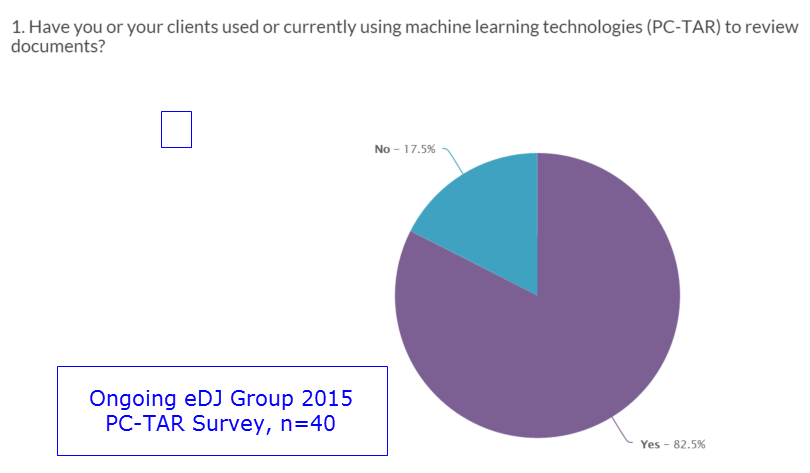Migrated from eDJGroupInc.com. Author: Greg Buckles. Published: 2015-11-10 19:00:00Format, images and links may no longer function correctly.
As I wind down my 2015 PC-TAR research, I have found some interesting trends driven by the new FRCP amendments and caselaw. Just like last year’s survey results, the numbers do not tell the whole story. With 82.5% of respondents (take the survey!) using PC-TAR to review documents, I could easily jump on the marketing bandwagon and say that it is being used by the majority of matters. I would be wrong. Just because a law firm or corporation has experimented with PC-TAR on a couple cases or been forced to use it due to time/volume constraints does not mean that they are using it for most of their matters. Instead of ramping up from last year’s usage estimate (5-7% of matters), many interviews revealed a laser focus on selective collections to produce proportionate, relevance rich reviews by a small inside/outside counsel team.
 We did not need PC-TAR in the bad old days when the average collection spanned 3-5 boxes of documents from the top five custodians. Live search and ECA access to the key unstructured data sources (email/files) can support proactive, iterative scoping efforts to control collection size. My validation testing of the Exchange 2010 search index found significant accuracy issues. Microsoft listened to the market feedback and the current FAST 2013 search index compares favorably in my testing with several other eDiscovery and archiving search systems. Best of all, it is free to O365 customers and the 2016 upgrades will enable hybrid searches across your content in the Cloud and in on-premise Exchange/SharePoint servers. With live search access, savvy teams with a documented scoping workflow may control overly broad collections and the demand for crowds of contract reviewers or PC-TAR.
We did not need PC-TAR in the bad old days when the average collection spanned 3-5 boxes of documents from the top five custodians. Live search and ECA access to the key unstructured data sources (email/files) can support proactive, iterative scoping efforts to control collection size. My validation testing of the Exchange 2010 search index found significant accuracy issues. Microsoft listened to the market feedback and the current FAST 2013 search index compares favorably in my testing with several other eDiscovery and archiving search systems. Best of all, it is free to O365 customers and the 2016 upgrades will enable hybrid searches across your content in the Cloud and in on-premise Exchange/SharePoint servers. With live search access, savvy teams with a documented scoping workflow may control overly broad collections and the demand for crowds of contract reviewers or PC-TAR.
But what about all the new data sources like mobile devices, social media, instant messaging and Cloud collaboration platforms? IT administrators and end users have search requirements that are driving distributed endpoint indexing solutions from providers like X1 and Heureka. The tools are out there and getting better. Do they meet the accuracy requirements of legal discovery scenarios? Only time and validation testing will answer that question. But I promise to share what I can as we support selection and implementation of the latest generation of live access technologies.
Greg Buckles wants your feedback, questions or project inquiries at Greg@eDJGroupInc.com. Contact him directly for a ‘Good Karma’ call. His active research topics include analytics, mobile device discovery, the discovery impact of the cloud, Microsoft’s Office 365/2013 eDiscovery Center and multi-matter discovery. Recent consulting engagements include managing preservation during enterprise migrations, legacy tape eliminations, retention enablement and many more.
Blog perspectives are personal opinions and should not be interpreted as a professional judgment. eDJ consultants are not journalists and perspectives are based on public information. Blog content is neither approved nor reviewed by any providers prior to being posted. Do you want to share your own perspective? eDJ Group is looking for practical, professional informative perspectives free of marketing fluff, hidden agendas or personal/product bias. Outside blogs will clearly indicate the author, company and any relevant affiliations.
